How do you feel with regards to Winter Plumbing Precautions: Preventing Frozen Pipes?

Cold weather can wreak havoc on your plumbing, particularly by freezing pipelines. Below's just how to stop it from occurring and what to do if it does.
Introduction
As temperatures decrease, the risk of icy pipelines boosts, potentially leading to costly repairs and water damages. Comprehending how to prevent icy pipelines is critical for home owners in chilly climates.
Recognizing Frozen Pipelines
What causes pipes to freeze?
Pipes ice up when exposed to temperatures listed below 32 ° F (0 ° C) for extended periods. As water inside the pipes ices up, it increases, taxing the pipe walls and possibly causing them to break.
Risks and damages
Icy pipelines can bring about supply of water disruptions, residential or commercial property damage, and expensive fixings. Burst pipes can flood homes and trigger comprehensive structural damage.
Indications of Frozen Water Lines
Determining frozen pipelines early can prevent them from breaking.
Exactly how to recognize frozen pipelines
Seek decreased water flow from taps, uncommon smells or sounds from pipelines, and noticeable frost on subjected pipes.
Prevention Tips
Insulating vulnerable pipes
Cover pipelines in insulation sleeves or utilize heat tape to protect them from freezing temperatures. Focus on pipes in unheated or external areas of the home.
Heating strategies
Keep interior rooms appropriately heated up, especially locations with plumbing. Open cupboard doors to allow warm air to flow around pipelines under sinks.
Securing Outdoor Pipes
Yard pipes and outdoor taps
Detach and drain yard tubes before wintertime. Mount frost-proof spigots or cover outside faucets with insulated caps.
What to Do If Your Pipes Freeze
Immediate actions to take
If you believe frozen pipes, keep taps available to soothe pressure as the ice thaws. Use a hairdryer or towels soaked in warm water to thaw pipelines slowly.
Long-Term Solutions
Structural modifications
Consider rerouting pipelines far from outside wall surfaces or unheated areas. Add extra insulation to attics, basements, and crawl spaces.
Upgrading insulation
Invest in high-grade insulation for pipelines, attic rooms, and walls. Appropriate insulation helps maintain consistent temperatures and reduces the threat of frozen pipes.
Verdict
Stopping frozen pipelines needs aggressive procedures and quick responses. By recognizing the causes, signs, and safety nets, property owners can protect their pipes during winter.
5 Ways to Prevent Frozen Pipes
Drain Outdoor Faucets and Disconnect Hoses
First, close the shut-off valve that controls the flow of water in the pipe to your outdoor faucet. Then, head outside to disconnect and drain your hose and open the outdoor faucet to allow the water to completely drain out of the line. Turn off the faucet when done. Finally, head back to the shut-off valve and drain the remaining water inside the pipe into a bucket or container. Additionally, if you have a home irrigation system, you should consider hiring an expert to clear the system of water each year.
Insulate Pipes
One of the best and most cost-effective methods for preventing frozen water pipes is to wrap your pipes with insulation. This is especially important for areas in your home that aren’t exposed to heat, such as an attic. We suggest using foam sleeves, which can typically be found at your local hardware store.
Keep Heat Running at 65
Your pipes are located inside your walls, and the temperature there is much colder than the rest of the house. To prevent your pipes from freezing, The Insurance Information Institute suggests that you keep your home heated to at least 65 degrees, even when traveling. You may want to invest in smart devices that can keep an eye on the temperature in your home while you’re away.
Leave Water Dripping
Moving water — even a small trickle — can prevent ice from forming inside your pipes. When freezing temps are imminent, start a drip of water from all faucets that serve exposed pipes. Leaving a few faucets running will also help relieve pressure inside the pipes and help prevent a rupture if the water inside freezes.
Open Cupboard Doors
Warm your kitchen and bathroom pipes by opening cupboards and vanities. You should also leave your interior doors ajar to help warm air circulate evenly throughout your home.

As a serious person who reads on How to prepare your home plumbing for winter weather, I imagined sharing that excerpt was important. So long as you appreciated our blog entry if you please be sure to pass it around. Thanks a lot for your time. Come back soon.
Request Your Service
Comments on “How to Maintain Your Pipes from Freezing Issues: Essential Tips”